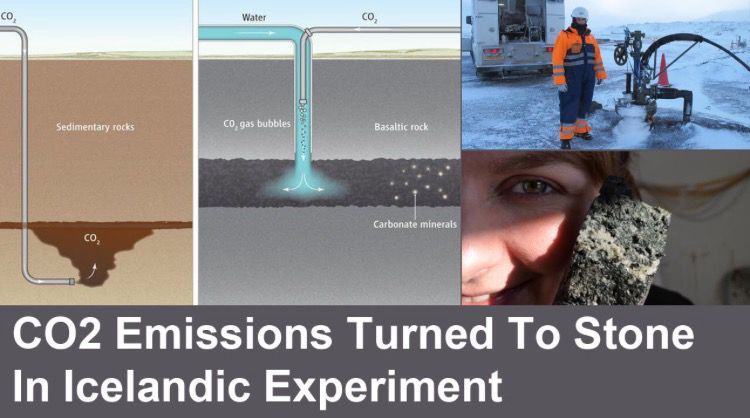CO2 to Stone
CO2 to Stone
This is another interesting fact about carbon dioxide, the gas that's blamed for climate change. It appears that researchers have found a way to turn CO2 in the atmosphere into stone under ground.
The research is underway at the Hellisheidi geothermal power plant near Reyhjavik, Iceland. As you might know, Iceland sits on a volcanic mess that has geysers and boiling water on the surface. It's about as close to the idea of Hell that one can get.
The idea here is to capture CO2 emissions from power plants and convert them to stone underground by dissolving the CO2 in saltwater and mixing it with basalt, a volcanic rock that lies underground near volcanoes. There are calcium compounds in basalt that when mixed into s slurry with carbonic acid makes calcium carbonate, which is a solid that's mostly insoluble. Right now, they are using pure water, not saltwater.

This method is less expensive than other CO2 capture methods. It uses readily available materials. However, it requires 25 tons of water to remove one ton of CO2. So, this means that saltwater will be needed.
The main other method is carbon sequestration. There are many ways to do this, and one is the planting of forests to soak up the CO2. This is where cover crops in farming are important. Another interesting method is Iron fertilization. This is an attempt to make phytoplankton grow, which convert CO2 to O2 by photosynthesis. Another method uses compression to concentrate the CO2 associated with oil and gas production. The liquid CO2 is stored, usually underground. Most of these methods are not practical or cost too much.
There is also a method to convert carbon dioxide in the atmosphere into Carbon monoxide, which could be used as a fuel. It uses Silicon, which is the most abundant element on Earth, and probably in the universe.
The test facility in Iceland has been scaled up to bury 10,000 tons of CO2 per year. Obviously, more capacity will be needed to remove the millions of tons of excess CO2 emitted into the atmosphere.
Some scientists are skeptical about this process. For one, there is a danger that volcanic eruptions could release tons of CO2 at one time, negating the process.
What's needed is more research. I'm sure we'll see that in the future.
Thanks for reading.
Bạn đang đọc truyện trên: Truyen247.Pro